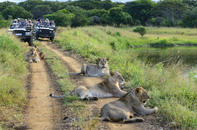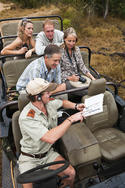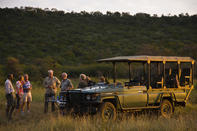Vehicle Seating
Game spotting trips are always random; there are no Big Five guarantees; and every good sighting requires effort. Sometimes you're lucky enough to spot animals before you've spent much time looking for them. But there is a special satisfaction when you have a great sighting after hours of searching and following tracks.

At most Southern African camps and lodges, open vehicles with raised, stepped seating, meaning the seats in the back are higher than the ones in front, are used for game drives. There are usually three rows of seats after the driver's row; the norm at a luxury lodge is to have two people per row. In the front row you'll have the clearest conversations with the ranger, but farther back you'll have a clearer, elevated view over the front of the car.
Whenever possible, avoid the back row; you're exposed to the most dust and feel the most bumps in these seats, and communicating with your ranger is difficult because of the rows between you. In closed vehicles, which are used by private touring companies operating in Kruger National Park, sit as close to the driver-guide as possible so you can get in and out of the vehicle more easily and get the best views.
Rangers and Trackers

Wildlife rangers (sometimes referred to as guides) tend to be of two types: those who have come to conservation by way of hunting and those who are professional conservationists. In both cases, they have vast experience with and knowledge of the bush and the animals that inhabit it.
Tourism and the advent of photographic safaris have led to new professional opportunities for these highly trained people, and you can take both pleasure and comfort in their company.
A ranger's job on safari is multifaceted: to entertain you, protect you, and put you as close to the wilderness as possible while serving as a bush mechanic, first-aid specialist, and host. This is no small feat, and each ranger has his particular strengths.
Because of the intensity of the safari experience, with its exposure to potentially dangerous animals and tricky situations, your relationship with your guide or ranger is a unique one of trust, friendliness, and respect. Misunderstandings may sometimes occur, but you're one step closer to ensuring that all goes well if you know the protocols and expectations.
Rangers work in conjunction with trackers, who sit in a special seat on the front of the four-wheel-drive vehicle, spot animals, and guide the rangers on where to go. If the tracker speaks good English and seems comfortable talking to you, consider discussing animals with him.
Tourist Behaviour

Acknowledge that the guide is a professional and an expert in the field, and defer to his knowledge. Instead of trying to show how much you know, follow the example of the hunter, which is to walk quietly and take notice of all little signs around you. Save social chatter with the guide for when you're back at camp, not out on a game drive. Rangers appreciate questions, which give them an idea of your range of knowledge and of how much detail to include in their animal descriptions.
However, if you like to ask a lot of questions, save some for later, especially as several other people are likely to be in the safari vehicle with you. Carry a pocket notebook on game drives and jot down questions as they occur; you can then bring them up at dinner or around the campfire, when your ranger has more time to talk and everyone can participate in the discussion.
You can expect your ranger or guide to treat you with respect: you are the client and he is the service provider, and you can expect delivery of that service 100% of the time. A guide should be pleasant and friendly but never too chummy or, worse, patronizing. If you believe a show-off guide or gung-ho ranger is speaking down to you, a quiet word with him should be enough to change his demeanor.
 The Big Five are the most well-known animals in South Africa. Not only will you find them in the bushveld, but their faces are printed on th...
The Big Five are the most well-known animals in South Africa. Not only will you find them in the bushveld, but their faces are printed on th... Be warned, the Kruger National Park can make people go crazy. The game reserve has a strange power which transforms normally mild-mannered a...
Be warned, the Kruger National Park can make people go crazy. The game reserve has a strange power which transforms normally mild-mannered a...